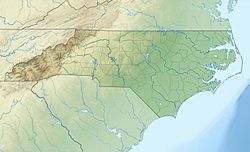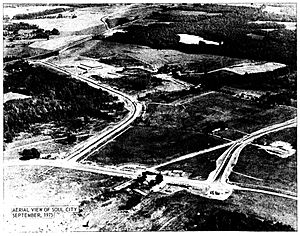Soul City, North Carolina facts for kids
Quick facts for kids
Soul City, North Carolina
|
|
|---|---|

Soul City sign at the entrance to Green Duke Village
|
|
| Country | |
| State | |
| County | Warren County |
| Established | 1969 |
| ZIP code |
27563
|
Soul City is a community in Warren County, North Carolina, United States. It was a planned community first suggested in 1969 by Floyd McKissick. He was a leader in the civil rights movement. McKissick also directed the Congress of Racial Equality.
The United States Department of Housing and Urban Development helped fund Soul City. It was one of thirteen special city projects under a law called the Urban Growth and New Community Development Act. Soul City was built on about 5,000 acres (20 km2) in Warren County. It was located near Manson-Axtell Road and Soul City Boulevard in Norlina.
Contents
Why Soul City Was Started
After the Civil Rights Act of 1968 was passed, many civil rights leaders focused on helping black communities grow economically. They wanted African Americans to use the new opportunities they had gained.
Floyd McKissick started a company called McKissick Enterprises in 1968. This company aimed to help black-owned businesses. It also wanted to share profits with many black Americans.
Choosing a Location
McKissick wanted to build a new city in the South. He felt it would get more attention there. He chose North Carolina because it was his home state. He also thought it was more open to new ideas than other Southern states.
McKissick's team looked for land. They found a large property in Warren County called the Circle P Ranch. It was a farm with woods, pastures, and old buildings. The owner wanted to sell it.
Warren County was a mostly black, rural area. It was one of the poorest counties in North Carolina. Many people were leaving the area. There were not many services like good roads or water systems. Even with these challenges, McKissick believed the land had potential. He thought the low labor costs would attract businesses. The location was also central to major cities. It was near a main road, U.S. Route 1, and a railroad. A large lake, Kerr Lake, was nearby for water. McKissick also felt it was meaningful to build a city for black people on land that was once a plantation.
Announcing the Plan
In 1968, McKissick bought the land. In January 1969, he announced his plan to build "Soul City." He said the project would help stop black people from moving away from the South. It would also help improve struggling areas. McKissick said Soul City would be "open to residents of all colors." He also stressed that it would create "new careers for black people." He wanted it to be a place where "black people welcome white people as equals."
McKissick's announcement got a lot of media attention. Some news outlets wondered if the project would make enough money. Others worried it might lead to black people separating from white people. Some people thought the plan relied too much on capitalism. However, many black newspapers and people were hopeful about the idea.
Building Soul City
After his announcement, McKissick hired architects to design Soul City. He also worked to get money to buy the land. He got a loan from Chase Bank and some money from a businessman. He also received grants from the federal government. The state of North Carolina, with support from Governor Bob Scott, helped McKissick get some of this money.
McKissick then hired Harvey Gantt to plan the city. Gantt was inspired by the design of Columbia, Maryland. He planned Soul City to have several villages around a main central area.
Goals and Plans for the City
Soul City was meant to be a brand new town. It would be open to people of all races. But it would especially focus on creating chances for minorities and poor people. The city aimed to stop people from moving from rural areas to crowded cities. Soul City would offer jobs, education, housing, training, and other services.
The plan was for Soul City to have three villages. These would house 18,000 people by 1989. By 2004, it was expected to have 24,000 jobs and 44,000 residents. The city would have businesses and shops for jobs. It would also have homes and services. People would be able to work, go to school, shop, get health care, and worship in town. Soul City was the first new town started by African-American businesses. McKissick wanted it to be a place where all races could live together peacefully.
Growth and Challenges
By 1974, the first families moved to Soul City. There was good progress. Water and sewer lines were put in. Roads were built. A day care center and a health care center were opened. Construction began on "Soul Tech I," a building for businesses.
However, Soul City faced challenges that led to its decline. These included the local economy, the national economy, and negative news coverage.
Economic Problems
Warren County had many people who had not finished high school. This meant there weren't enough skilled workers for some businesses. This made some companies hesitant to move to Soul City.
The U.S. economy also had a major downturn in the 1970s. Prices went up very fast, and there were not enough jobs. This period was called "stagflation." Because of these tough economic times, many companies were careful about expanding. Some companies that planned to move to Soul City stopped their plans. Some people believe that Soul City and other new town projects would have succeeded if the economy had been better.
Negative News Coverage
Some news companies reported on Soul City as a "new black town." This made it less appealing for white families to move there. A major business newspaper, Wall Street Journal, wrote negative stories about McKissick. This hurt his reputation and made it harder for him to attract new businesses.
Soul City did not reach its original goals. There were also investigations into how the city's developers used their money. Even though these investigations later found no wrongdoing, the city lost its funding in 1979.
Soul City Today
Soul City did not become as large as Floyd McKissick had hoped. However, the project still had some positive results. Soul City brought the first health care center to Warren County. It also created a water system for three counties and a sewage system.
Before Soul City, many African Americans were moving from the South to northern cities. But after Soul City was created, more African Americans moved to North Carolina than left it in the 1970s. This was the first time this had happened since the Reconstruction Era.
By 1980, Soul City had 35 housing units, a clinic, a tennis court, and a pool. About 150 people worked in the community. The former Soultech 1 building was bought by the nearby Warren County Correctional Institution for expansion. Some new homes have also been built.





